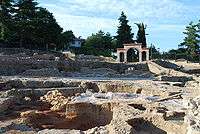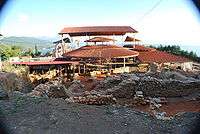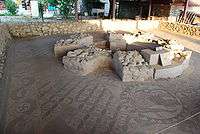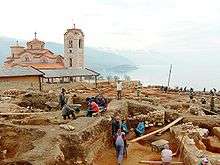Plaošnik




Plaošnik or simply Plaoš (Macedonian: Плаошник, Плаош) is an archaeological site and holy place in Ohrid, 250 meters below Samuil's Fortress. In the future, the whole complex will have konaks (mansions) as in the time of Saint Clement of Ohrid, together with several surrounding objects.[1]
Archaeological sites
St. Clement’s Church
The church was built by St.Clement in 893 year on the foundation of an early Christian basilica, and dedicated to St.Panteleimon. It was here that the Ohrid Literary School, a center of Slavonic literary and cultural activity where it was educated more than 3,500 disciples. St. Clement was buried in this monastery, in the tomb which was built by his own hands.
After the advent of the Ottoman Turks, St. Clement’s Church was converted into a mosque, known as the Imaret Mosque, of which only a small enclosure remains. The mosque was built as an endowment and a memorial by Sinan Chelebi, member of the distinguished Turkish family of the Ohrizade.[2]
Apart from the monastery's many reconstructions during the Ottoman empire, it has recently undergone extensive reconstruction and excavation. Reconstruction started on 8 December 2000 and the physical church was fully reconstructed by 10 August 2002. Most of Saint Clement's relics were returned to the church.
- Baptistery
On Plaošnik has been discovered the baptistery of the five aisle basilica with hooked crosses (swastikas) on the mosaic floors which date from the period between 4th and 6th century. It is assumed that this early Christian basilica at Plaoshnik upon which the Kliment’s monastery was built in the 9th century, was dedicated to St. Paul, the apostle. In Lichnid (present day Ohrid), the apostle Paul preached Christianity in the 1st century A.D.[3]
On 10 October 2007, a deposit of approximately 2,383 Venetian coins was discovered by archaeologists while excavating the monastery. A prominent archaeologist of the Republic of Macedonia, Pasko Kuzman, stated that the coins are of special significance because they indicate that Ohrid and Venice were commercially linked.[4]
See also
References
- ↑ Ohrid – “Plaosnik” will look the same as in the time of St. Kliment
- ↑ Journey to Macedonia Part II: St. Clement of Ohrid, Fr Samuel, December, 2006
- ↑ Institute of Conservation and Restoration and Museum – Ohrid; Plaoshnik, Then and now -Brochure No. 6
- ↑ Culture – Republic of Macedonia Archaeology – Depot with Venetian Silver Coins Excavated, Večer, 10 October 2007
| Wikimedia Commons has media related to Plaošnik. |
Galery
 Plaošnik
Plaošnik Swastika
Swastika Some archaeological works on Plaošnik
Some archaeological works on Plaošnik
Coordinates: 41°06′45.85″N 20°47′28.48″E / 41.1127361°N 20.7912444°E
.svg.png)